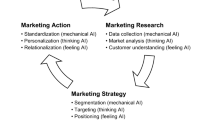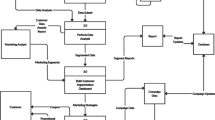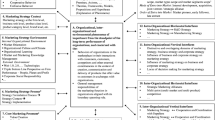Abstract
With the growth in ancillary sales, an area of increasing importance for airlines is the concept of offer management, which entails the creation of dynamic, custom, personalized offers consisting of a flight itinerary and ancillary products offered by an airline. This practice-oriented, overview paper provides an end-to-end, future-oriented framework for determining the composition of optimal base fare and ancillary bundles by customer trip-purpose segment followed by 1:1 personalization to maximize total sales. Our focus in this paper is primarily on the proposed offer management framework and its sub-components.







Similar content being viewed by others
Notes
Air Canada currently has the Air Canada Altitude Program https://altitude.aircanada.com/status/home.
References
Alexander, K.L. 2006. Paying more for small extras. Washington Post, January 31. http://www.washingtonpost.com/wp-dyn/content/article/2006/01/30/AR2006013001282.html.
Balcombe, K., I. Fraser, and L. Harris. 2009. Consumer willingness to pay for in-flight service and comfort levels: A choice experiment. Journal of Air Transport Management 15: 221–226.
Ben-Akiva, M., and S. Lerman. 1985. Discrete choice analysis: Theory and application to travel demand. Cambridge, MA: MIT Press.
Besbes, O., and A. Zeevi. 2015. On the (surprising) sufficiency of linear models for dynamic pricing with demand learning. Management Science 61 (4): 723–739.
Cary, D. 2004. A view from the inside. Journal of Pricing and Revenue Management 3 (2): 200–203.
Choubert, L., T. Fiig, and V. Viale. 2015. “Amadeus Dynamic Pricing”, presentation at the AGIFORS Revenue Management and Distribution Study Group meeting, Shanghai, China.
Gallego, G., and M. Hu. 2014. Dynamic pricing of perishable assets under competition. Management Science 60 (5): 1241–1259.
Green, P.E., A.M. Krieger, and Y. Wind. 2001. Thirty years of conjoint analysis: Reflections and prospects. Interfaces 31: S56–S73.
Hague, N. 2008. The problem with price. B2B International. http://www.b2binternational.com/library/whitepapers/pdf/the_problem_with_price.pdf.
Hair, J.S., R.E. Anderson, and R.T. Tatham. 1984. Multivariate data analysis with readings, 2nd ed. New York: Macmillan.
IdeaWorks. 2016. Airline ancillary revenue projected to be $67.4 billion worldwide in 2016. Press release, 29 Nov. 29, 2016. No. 115. http://www.ideaworkscompany.com/wp-content/uploads/2016/11/Press-Release-115-Global-Estimate.pdf.
Martin, J.C., C. Roman, and R. Espino. 2008. Willingness to pay for airline service quality. Transportation Reviews 28 (2): 199–217.
Nason, S.D. 2009. The future of a la carte pricing in the airline industry. Journal of Revenue and Pricing Management 8 (5): 467–468.
Ødegaard, F., and J.G. Wilson. 2016. Dynamic pricing of primary products and ancillary services. European Journal of Operational Research 251 (2): 586–599.
Ratliff, R.M., A. Walker, B.C. Smith, and T. Brice. 2003. Availability based value creation method and systems, U.S. Patent 20030191725, filed March 26, 2003, and issued October 9, 2003.
Ratliff, R.M. 2016. A business overview of market adaptive dynamic pricing. Sabre white paper.
Ratliff, R., and G. Gallego. 2013. Estimating sales and profitability impacts of airline branded-fares product design and pricing decisions using customer choice models. Journal of Revenue and Pricing Management 12 (6): 509–523.
Ratliff, R.M., and B. Vinod. 2005. Airline pricing and revenue management: A future outlook. Journal of Revenue and Pricing Management 4 (3): 302–307.
Ratliff, R.M., and B. Vinod. 2016. An applied process for airline strategic fare optimization. Journal of Revenue and Pricing Management 15 (5): 320–333.
Rickey, D. 2014. Total revenue management. Ascend 13 (4): 20–22.
Scott, S. 2010. A modern Bayesian look at the multi-armed bandit. Applied Stochastic Models in Business and Industry 26: 639–658.
Smith, B.C., R. Darrow, J. Elieson, D. Guenther, B.V. Rao, and F. Zouaoui. 2006. Travelocity becomes a travel retailer. Interfaces 37 (1): 68–81.
Train, K.E. 2003. Discrete choice methods with simulation. New York: Cambridge University Press.
van Westendorp, P.H. 1976. NSS—price sensitivity meter (PSM)—a new approach to study consumer perception of price. Proceedings of the ESOMAR Congress, Venice.
Vinod, B. 2008. The continuing evolution: Customer centric revenue management. Journal of Revenue and Pricing Management 7 (1): 27–39.
Vinod, B. 2015. The expanding role of revenue management in the airline industry. Journal of Revenue and Pricing Management 14 (6): 391–399.
Vinod, B., and K. Moore. 2009. Promoting branded fare families and ancillary services: Merchandising and its impacts on the travel value chain. Journal of Revenue and Pricing Management 8 (2–3): 174–186.
Zouaoui, F., and B.V. Rao. 2009. Dynamic pricing of opaque airline tickets. Journal of Revenue and Pricing Management 8 (2–3): 148–154.
Author information
Authors and Affiliations
Corresponding author
Rights and permissions
About this article
Cite this article
Vinod, B., Ratliff, R. & Jayaram, V. An approach to offer management: maximizing sales with fare products and ancillaries. J Revenue Pricing Manag 17, 91–101 (2018). https://doi.org/10.1057/s41272-017-0121-1
Revised:
Published:
Issue Date:
DOI: https://doi.org/10.1057/s41272-017-0121-1




